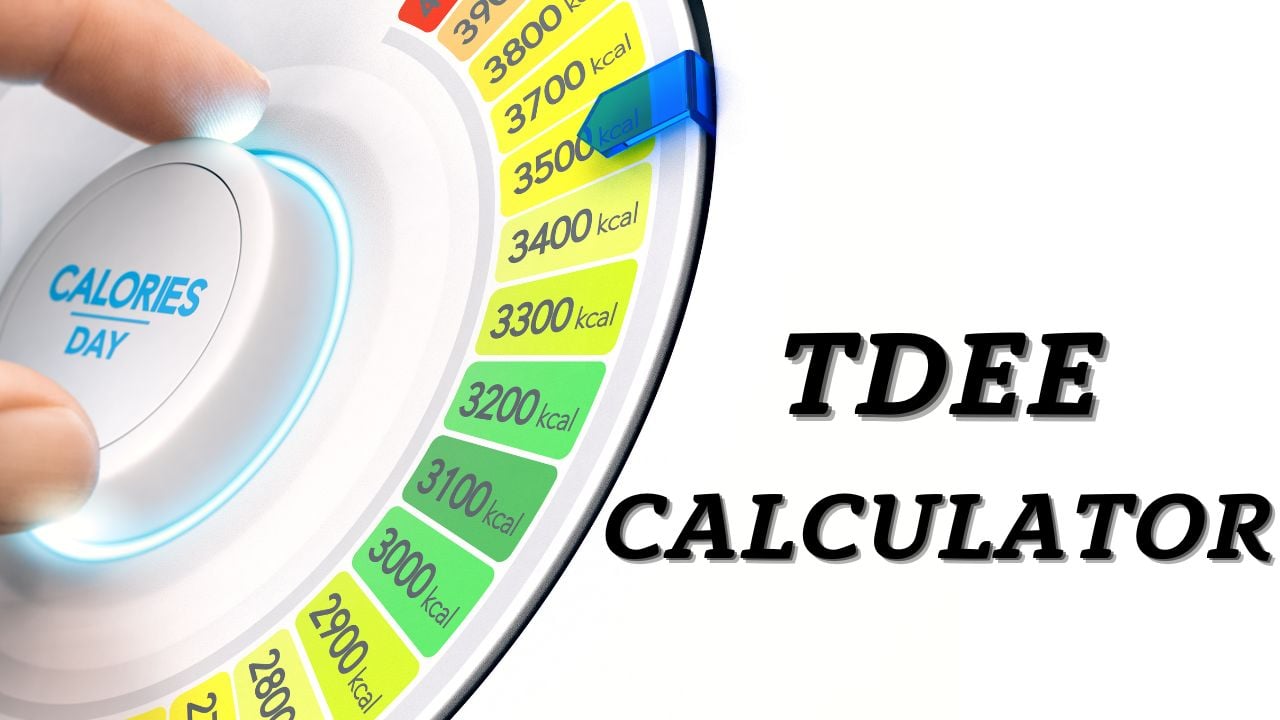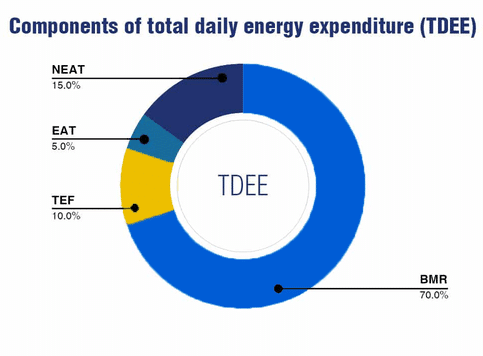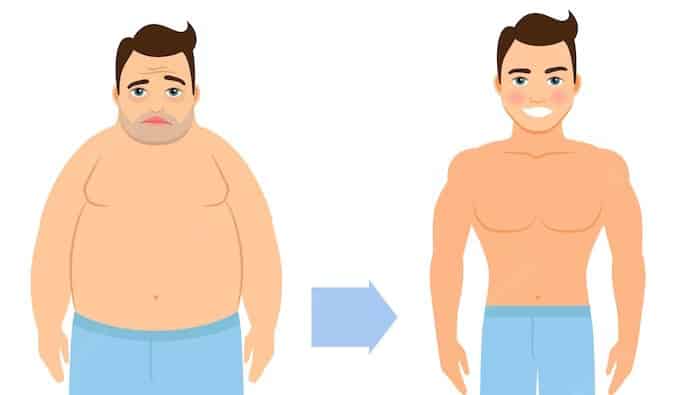
TDEE Calculator
Your TDEE: _____ Calories/day
Daily calorie needs based on your activity level:
| Activity Level | Calorie |
|---|---|
| Sedentary (little or no exercise) | |
| Light (Exercise 1-3 times/week) | |
| Moderate (Exercise 3-5 times/week) | |
| Very Active (Exercise 6-7 times/week) | |
| Extra Active (Extra heavy workouts) |
What Is TDEE
TDEE (Total Daily Energy Expenditure) is the total number of calories a person burns daily, including calories burned through basic bodily functions (such as breathing and heartbeat), physical activity, and digestion. It represents the amount of energy a person needs to maintain their current weight.
To create a diet plan that will help you maintain your current weight, lose weight, or gain weight, it is essential to comprehend the idea of TDEE.
It is calculated by considering your BMR (Basal Metabolic Rate), your activity level, and the thermic effect of food (TEF).
Various factors, including age, gender, weight, height, body composition, physical activity level, hormones, genetics, and health conditions, influence TDEE.

TDEE Components To Calculate Calories Requirement
TDEE (Total Daily Energy Expenditure) has four main components:
- BMR = Basal Metabolic Rate
- NEAT = Non-Exercise Activity Thermogenesis
- EAT = Exercise Activity Thermogenesis
- TEF = Thermic Effect of Food
1. Basal Metabolic Rate (BMR)
BMR stands for Basal Metabolic Rate, the minimum amount of energy or calories required to sustain essential bodily functions while at rest. These functions include breathing, blood circulation, and organ function.
While RMR (resting metabolic rate) and BMR (basal metabolic rate) are often used interchangeably, they have distinct differences.
RMR is slightly higher than BMR because it includes the calories your body burns for a few additional normal, healthy functions.
- RMR is the calories your body burns while resting, but not asleep. This includes the calories your body burns to keep your organs functioning, maintain your body temperature, and breathe.
- BMR is the number of calories your body burns while you are asleep. This is the lowest number of calories your body burns at any time.
BMR accounts for around 60-70% of total energy expenditure. Age, gender, weight, height, and body composition can affect BMR.
- Body size: The larger you are, the higher your BMR. This is because your body needs more energy to maintain its essential functions.
- Body composition: The more lean muscle mass you have, the higher your BMR. Muscles are more metabolically active than fat and burn more calories at rest.
- Sex: Men typically have a higher BMR than women due to differences in body composition and muscle mass.
- Age: BMR decreases with age. This decrease in BMR is attributed to several factors, including loss of muscle mass, changes in hormonal levels, and reduced physical activity.
Use Free Calculator To Know Your BMI
2. Non-Exercise Activity Thermogenesis (NEAT)
NEAT refers to the energy or calories the body burns during daily activities that are not considered exercise or planned physical activity, such as walking to work, gardening, or fidgeting.
NEAT can account for a significant portion of total daily energy expenditure, especially for people who lead active lifestyles.
Physical activity, such as taking the stairs instead of the lift or standing instead of sitting, can help increase energy expenditure.
Your NEAT will be higher if you move more throughout the day, including standing, walking, carrying things, etc.
3. Exercise Activity Thermogenesis (EAT)
It is one of the important components used to calculate Total Daily Energy Expenditure (TDEE).
Exercise Activity Thermogenesis (EAT) is the energy expended during planned physical activity, such as running, weightlifting, or cycling, or HIIT workouts.
Factors such as the type of exercise, workout duration, and intensity significantly impact the number of calories burned during physical activity.
- For competitive athletes, EAT may account for around 30-50% of their total daily energy expenditure (TDEE).
- However, for recreational athletes, exercise’s contribution to TDEE might be closer to 15-25%.
- For a sedentary person, the contribution of exercise to TDEE could be as low as 5-10%.
4. Thermic Effect of Food (TEF)
TEF is the amount of energy or calories the body uses to digest, absorb, and process foods. It is a small percentage of an average daily energy expenditure, typically ranging from 5% to 15%.
The study has shown that factors such as the type and amount of food consumed, metabolised nutrients, and metabolic rate influence diet-induced thermogenesis.
TEF has a relatively minor impact on TDEE calculations compared to BMR and activity level. Therefore, it is usually not considered when calculating TDEE.
Protein, for example, has a significantly larger thermic effect than dietary fat, as it is more difficult to digest.
The thermic effect of nutrients, expressed as a percentage of their energy content, is 2-3% for lipids, 6-8% for carbohydrates, and 25-30% for proteins.

Refer to the table below to better understand each component’s contribution to Total Daily Energy Expenditure (TDEE) calculations.
| Component of TDEE | Components of TDEE | 1600 kcal TDEE | 2600 kcal TDEE | 3600 kcal TDEE |
|---|---|---|---|---|
| Thermic Effect of Food (TEF) | 8-15% | 128-240 | 208-390 | 288-540 |
| Exercise Activity Thermogenesis (EAT) | 15-30% | 240-480 | 390-780 | 540-1080 |
| Non-Exercise Activity Thermogenesis (NEAT) | 15-50% | 240-800 | 390-1300 | 540-1800 |
| Basal Metabolic Rate (BMR) | 60-70% | 960-1120 | 1560-1820 | 2160-2520 |
BMR has the highest percentage contribution, followed by NEAT, EAT, and TEF.
However, the actual contribution of each component may vary depending on factors such as age, gender, weight, and activity level.
How To Calculate TDEE
Here is how you can calculate your TDEE:
1. Determine Your BMR
A study comparing various popular RMR equations, including the Harris-Benedict, Mifflin-St Jeor, Owen, and WHO/FAO/UNU formulas, revealed that the Mifflin-St Jeor formula emerged as the most accurate among them.
The Mifflin-St Jeor Equation is a reliable method for calculating RMR, which closely approximates BMR and can serve as a suitable substitute.
Use an online BMR calculator or the Mifflin-St Jeor Equation to estimate your BMR based on your age, gender, weight, and height.
- For men: BMR = (10 x weight in kg) + (6.25 x height in cm) – (5 x age in years) + 5
- For women: BMR = (10 x weight in kg) + (6.25 x height in cm) – (5 x age in years) – 161
The American Council on Exercise reports that your BMR represents about 60-75% of the total calories you burn in a day. However, it depends relatively on how active you are, both in terms of planned exercise and physical activity accumulated throughout your day.
2. Estimate Your Activity Level
After determining your BMR, multiply it by your physical activity level to calculate your TDEE. Based on your daily routine and exercise habits, estimate the number of calories you burn through physical activity.
There are several ways to do this, but a common method is to use an activity multiplier:
| Activity Level | Multiplier |
|---|---|
| Sedentary (little or no exercise) | BMR x 1.2 |
| Lightly active (1-3 days of exercise/week) | BMR x 1.375 |
| Moderately active (3-5 days of exercise/week) | BMR x 1.55 |
| Very active (6-7 days of exercise/week) | BMR x 1.725 |
| Extra active (very intense exercise or physical job) | BMR x 1.9 |
3. Your TDEE Is:
- TDEE = BMR x Activity Level
Use Our Free Calculator To Know Your body Fat Percentage
Factors that Affect TDEE
Several factors influence TDEE, including:
- Age: As we age, our TDEE tends to decrease, primarily due to a decline in muscle mass.
- Gender: Men tend to have a higher TDEE than women due to differences in body composition and hormonal profiles.
- Weight: The more you weigh, the higher your TDEE will be, as it requires more energy to move a heavier body.
- Height: Taller individuals tend to have a higher TDEE due to having a larger body surface area.
- Body Composition: Muscle mass burns more calories than fat, so individuals with higher muscle mass tend to have a higher TDEE.
- Physical Activity Level: The more physically active you are, the higher your TDEE will be, as exercise burns calories.
- Hormones and Genetics: Hormonal imbalances and genetic factors can impact TDEE by influencing metabolism and muscle mass.
- Health Conditions and Medications: Certain health conditions and medications can affect TDEE by altering factors such as metabolism and energy expenditure.
What Are The Ways To Use TDEE To Lose Weight?
To lose weight, you must create a calorie deficit, which means consuming fewer calories than your TDEE. This can be achieved in several ways, including:
- Calorie tracking: Use a food diary or app to track your daily calorie intake and compare it to your TDEE. Adjust your calorie intake as needed to create a calorie deficit.
- Reducing portion sizes: You can reduce your calorie intake by eating smaller portions.
- Increasing physical activity: Exercise burns calories, so increasing your physical activity can help create a calorie deficit.
- Eating low-calorie, nutrient-dense foods: Choosing foods that are low in calories but high in nutrients, such as vegetables and lean protein, can help you stay full while consuming fewer calories.
- Limiting high-calorie, low-nutrient foods: Avoid or limit high-calorie, low-nutrient foods, such as processed snacks and sugary drinks, as they can contribute to weight gain.
Aiming for a calorie deficit of 500–1000 calories per day is generally recommended, which can lead to a weight loss of 1–2 pounds per week.
Free Calculator: Know How Many Calories You Need To Lose Weight

TDEE Calories Required To Lose Weight
Once you have calculated your TDEE, you can adjust your calorie intake to achieve your desired weight loss or gain.
You must create a calorie deficit by consuming fewer calories than your TDEE to lose weight. A daily deficit of 500–1000 calories is recommended for safe and sustainable weight loss.
Approximately 1 kg of body fat contains 7,700 calories.
To lose weight, 0.25 kg/week
- = (0.25 kg x 7700 calories/kg ÷ 7 days/week).
- You need a 275-calorie deficit per day.
- If your TDEE is 2000 calories per day, you should consume 1725 calories per day (2000 – 275) to lose 0.25 kg per week.
To lose weight, 0.5 kg/week
- = (0.5 x 7700 ÷ 7).
- You need a 550-calorie deficit per day.
- If your TDEE is 2000 calories per day, you should consume 1450 calories per day (2000 – 550) to lose 0.5 kg per week.
Please consult a doctor if you lose 1 kg or more per week, as this requires consuming fewer than the minimum recommended 1,200 calories per day.
What Are The Ways Of Using TDEE To Gain Weight?
You must create a calorie surplus to gain weight, which means consuming more calories than your TDEE. Here are some ways to use TDEE to gain weight:
- Calculate your TDEE: Start by calculating your TDEE using an online TDEE calculator or a formula. This will give you an idea of the number of calories your body needs to maintain its current weight.
- Add calories to your diet: To gain weight, you need to consume more calories than your TDEE. Aim to add around 500 calories to your daily diet, which should help you gain around 1 pound per week.
- Choose healthy, high-calorie foods: Opt for nutrient-dense, high-calorie foods like nuts, avocados, whole grains, lean protein, and healthy fats. Avoid filling up on empty calories such as sugary drinks and junk food.
- Eat frequently: Consuming smaller meals more regularly can help you consume more calories throughout the day. Aim for 3–4 meals daily, with 1–2 snacks in between.
- Lift weights: Resistance training can help build muscle mass, which can contribute to weight gain. At least 2–3 times per week, aim to lift weights or perform bodyweight exercises.
- Be consistent: Consistency is key when it comes to weight gain. Ensure you consume enough calories daily and stay active to build muscle mass.
Free Calculator: Know How Many Calories You Need To Gain Weight

TDEE Calories Required To Gain Weight
To gain weight, you need to consume more calories than your TDEE, typically in the range of 250–500 calories per day.
Keep track of your calorie intake and make gradual adjustments to ensure you’re on track towards your goal.
To Gain Weight 0.25 kg/week
- = (0.25 kg x 7700 calories/kg ÷ 7 days/week).
- You need a 275-calorie daily surplus.
- If your TDEE is 2000 calories per day, you should consume 2275 calories per day (2000 + 275) to gain 0.25 kg per week.
To Gain Weight 0.5 kg/week
- = (0.5 × 7700 ÷ 7).
- You need a 550-calorie daily surplus.
- If your TDEE is 2000 calories per day, you should consume 1450 calories per day (2000 + 550) to gain 0.5 kg per week.
When losing 1 kg or more per week, please consult a doctor, as it requires you to consume fewer than the minimum recommended 1,200 calories per day.
Formulas For Calculating TDEE
Several formulas can be used to calculate TDEE.
- Mifflin-St. Jeor equations
- Harris-Benedict equation
- Katch-McArdle equation
- Cunningham equation
- Owen equation
Here is how you can calculate your TDEE.
- Determine your BMR
- Estimate your activity level
- TDEE = BMR x Activity level
1. Mifflin-St. Jeor Equation
Our calculator tool above uses the Mifflin-St. Jeor equation, which is thought to be the most accurate estimate.
- For men: BMR = (10 x weight in kg) + (6.25 x height in cm) – (5 x age in years) + 5
- For women: BMR = (10 x weight in kg) + (6.25 x height in cm) – (5 x age in years) – 161
Mifflin-St. Jeor Equation Example To Estimate TDEE:
Let’s say a 40-year-old female weighs 70 kilograms (154 pounds) and is 170 centimetres (5 feet 7 inches) tall.
To calculate her estimated BMR using the Mifflin-St.. Jeor equation, we need to use the following formula:
- BMR = (10 x weight in kg) + (6.25 x height in cm) – (5 x age in years) – 161
Substituting the values into the equation to get BMR:
- = (10 x 70) + (6.25 x 170) – (5 x 40) – 161
- = 700 + 1062.5 – 200 – 161
- = 1,401.5 calories per day
TDEE for Lightly active (1-3 days of exercise per week): BMR x 1.375
- TDEE =1401.5 x 1.375
- TDEE = 1927.06
This is the total calories you could eat every day if you wanted to maintain your weight.
To lose weight, you must consume fewer calories daily, increase your physical activity level, or do both.
2. Harris-Benedict Equation
Many experts consider the Revised Harris-Benedict equation to be the accurate BMR calculation for most types of people.
Here’s how it works:
- For men: BMR = 88.36 + (13.4 x weight in kg) + (4.8 x height in cm) – (5.7 x age in years)
- For women: BMR = 447.6 + (9.2 x weight in kg) + (3.1 x height in cm) – (4.3 x age in years)
Harris-Benedict Equation Example To Estimate BMR:
Let’s say a 40-year-old female weighs 70 kilograms (154 pounds) and is 170 centimetres (5 feet 7 inches) tall.
To calculate her estimated BMR using the Harris-Benedict equation, we need to use the following formula:
- BMR = 655.1 + (9.563 x weight in kg) + (1.85 x height in cm) – (4.676 x age in years)
Substituting the values into the equation to get BMR:
- = 655.1 + (9.563 x 70) + (1.85 x 170) – (4.676 x 40)
- = 655.1 + 669.61 + 314.5 – 187.04 BMR
- = 1,452.17 calories per day
The estimated BMR using the Harris-Benedict equation is 1,452.17 calories per day.
TDEE for Lightly active (1-3 days of exercise per week): BMR x 1.375
- TDEE =1452.17 x 1.375
- TDEE = 1996.73
3. Katch-McArdle Equation
The Katch-McArdle equation is a formula that can be used to estimate BMR for people who know their body fat percentage.
The equation considers lean body mass, which is the body’s weight minus the amount of fat.
The Katch-McArdle equation is:
- BMR = 370 + (21.6 x lean body mass in kg)
The Katch-McArdle equation is considered more accurate than the Harris-Benedict and Mifflin-St. equations. Jeor equations because it considers body composition.
However, the accuracy depends on the accuracy of the body fat measurement.
How To Get Lean Body Mass
You need to have their body fat percentage to calculate lean body mass.
To measure lean body fat, you can use skin fold caliper measurements, bioelectrical impedance analysis, or dual-energy X-ray absorptiometry (DEXA).
Katch-McArdle Equation Example To Estimate TDEE:
Let’s say a 35-year-old male weighs 80 kilograms (176 pounds) and has a body fat percentage of 20%.
To calculate his lean body mass, we need to multiply his weight by (100 – body fat percentage) as follows:
- Lean body mass = 80 kg x (100% – 20%) = 64 kg
Estimated BMR using the Katch-McArdle equation.
- = 370 + (21.6 x lean body mass in kg) BMR
- = 370 + (21.6 x 64) BMR
- = 370 + 1,382.4 BMR
- = 1,752.4 calories per day
TDEE for Lightly active (1-3 days of exercise per week): BMR x 1.375
- TDEE =1752.4 x 1.375
- TDEE = 2409.55
4. Cunningham Equation
The Cunningham equation is a formula for estimating BMR for people who know their body fat percentage.
The equation considers an individual’s lean body mass, which is calculated by subtracting body fat from body weight.
The Cunningham equation is:
- BMR = 500 + (22 x lean body mass in kg)
Cunningham Equation Example To Estimate TDEE:
Let’s say a 35-year-old male weighs 80 kilograms (176 pounds) and has a body fat percentage of 20%. To calculate his lean body mass, we need to multiply his weight by (100 – body fat percentage) as follows:
- Lean body mass = 80 kg x (100% – 20%) = 64 kg
Estimated BMR using the Cunningham equation:
- = 500 + (22 x lean body mass in kg) BMR
- = 500 + (22 x 64) BMR
- = 500 + 1,408 BMR
- = 1,908 calories per day
The estimated BMR is 1,908 calories per day.
TDEE for Moderately active (3-5 days of exercise per week): BMR x 1.55
- TDEE =1752.4 x 1.55
- TDEE = 2716.22
Related
- Basketball Calories Burned Calculator
- Badminton Calories Burned Calculator
- Boxing Calories Burned Calculator
- Plank Calories Burned Calculator
- Burpee Calories Burned Calculator
- Crunches Calories Burned Calculator
- Sit-Up Calories Burned
- Zumba Calories Burned Calculator
- Pull Up Calories Burned Calculator
- Push-Up Calories Burned Calculator
- Home Activities Calories Burned Calculator
- Exercise Calories Burned Calculator
- Running Calorie Calculator
- Walking Calorie Burned Calculator
References:
- Johnstone AM, Murison SD, Duncan JS, Rance KA, Speakman JR, Factors influencing variation in basal metabolic rate include fat-free mass, fat mass, age, and circulating thyroxine but not sex, circulating leptin, or triiodothyronine1. Am J Clin Nutr 2005; 82: 941-948.
- Tooze JA, Schoeller DA, Subar AF, Kipnis V, Schatzkin A, Troiano RP. Total daily energy expenditure among middle-aged men and women: the OPEN Study. Am J Clin Nutr. 2007;86:382–387.
- Schwarz, N. A., Rigby, B. R., La Bounty, P., Shelmadine, B., & Bowden, R. G. (2011). A Review of Weight Control Strategies and Their Effects on the Regulation of Hormonal Balance. Journal of Nutrition and Metabolism, 2011.
- Buchholz, A. C., Rafii, M., & Pencharz, P. B. (2001). Is the resting metabolic rate different between men and women? British Journal of Nutrition, 86(6), 641–646.
- Pinheiro Volp AC, Esteves de Oliveira FC, Duarte Moreira Alves R, Esteves EA, Bressan J. Energy expenditure: components and evaluation methods. Nutr Hosp. 2011;26:430–440.
- Sparti A, DeLany JP, de la Bretonne JA, Sander GE, Bray GA. Relationship between resting metabolic rate and the composition of the fat-free mass. Metabolism. 1997;46:1225–1230.
- Contributors, W. E. (n.d.-a). Differences Between BMR and RMR. WebMD. Retrieved December 5, 2022, from: https://www.webmd.com/fitness-exercise/difference-between-bmr-and-rmr

Manish is a NASM-certified fitness and nutrition coach with over 10 years of experience in weight lifting and fat loss fitness coaching. He specializes in gym-based training and has a lot of knowledge about exercise, lifting technique, biomechanics, and more.
Through “Fit Life Regime,” he generously shares the insights he’s gained over a decade in the field. His goal is to equip others with the knowledge to start their own fitness journey.
